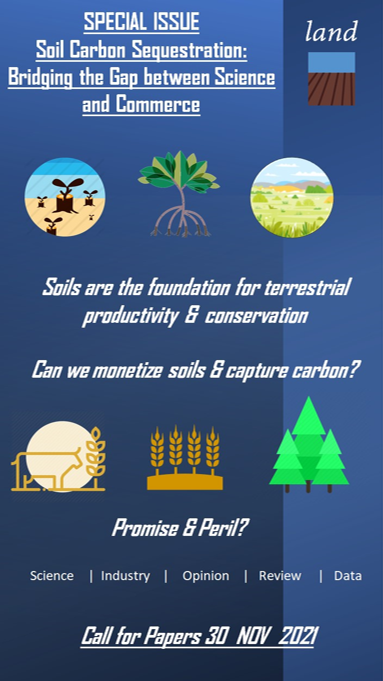Soil Carbon Sequestration: Bridging the Gap between Science and Commerce
A special issue of Land (ISSN 2073-445X). This special issue belongs to the section "Land–Climate Interactions".
Deadline for manuscript submissions: closed (30 November 2021) | Viewed by 14757
.png)
Special Issue Editors
Interests: soil carbon; forest carbon; eddy covariance; CO2 emissions; isotope; soil CO efflux; Paris agreement
Special Issue Information
Dear Colleagues,
We recognize that soil and soil carbon are the foundation for literally all our food production and livelihood that depends on the land. The commercial industries that impact soil and soil carbon include cattle ranching, agroforestry, community and high productivity farming, among many other uses by communities and individuals. We appeal for contributions from industry to science to thought leaders.
Active soil carbon sequestration (SCS) is an emerging commercial solution to CO2 emissions management, partially driven by entrepreneurs seeking financial returns and social good. However, claims of net SCS reduction and resulting financial products are unverified and subject to invalidation risk, diminishing SCS’s potential impact.
Cultural practices promoting “soil health” are argued as effective for SCS, while soil scientists broadly dismiss the likelihood of success in demonstrating net reductions of atmospheric CO2 relevant to climate change management. Soil carbon’s magnitude (approximately three times that of the atmosphere), the global scale of increasing anthropogenic interactions (via deforestation, agriculture, etc.), and climate change’s unknown impact on soil carbon expose surprising gaps in the translation of science to commercial SCS management. These gaps are crucial to commercial-scale sustainable management of soil carbon and related CO2 emissions, yet innovation to bridge the “know-how” gap between science and commerce is missing.

This Special Issue explores the intersection of soil carbon science, net SCS verification frameworks, and monetization to financial markets. The Special Issue’s theme extends across the terrestrial biosphere, from pole to pole, across policy (e.g., Paris Agreement and REDD+) domains, biospheric applications (e.g., forestry, agroforestry, and intensive agriculture), and carbon trading platforms worldwide (both voluntary and compliance).
Importantly, this Special Issue seeks innovative contributions that propose or demonstrate a set of unifying measurements, models, and transactions to account for, manage, and monetize SCS with net benefit to the atmospheric burden of CO2. As such, this Special Issue encourages diverse SCS collaborations involving networked sensors (e.g., the Internet of Things), real-time data analysis, and integration with global carbon pricing platforms.
This Special Issue is relevant because contemporary society is in a strange conflict with our self-induced climate change, whereby humanity’s success depends upon diminishing natural resources that sustain our way of life. The biosphere’s soil carbon component will surely impact our lives in the short term. However, what we do as scientists and entrepreneurs now to sustain and manage soil carbon will shape the biosphere for future generations.
Dr. Bruno Marino
Prof. Dr. Eugene Kelly
Guest Editors
Manuscript Submission Information
Manuscripts should be submitted online at www.mdpi.com by registering and logging in to this website. Once you are registered, click here to go to the submission form. Manuscripts can be submitted until the deadline. All submissions that pass pre-check are peer-reviewed. Accepted papers will be published continuously in the journal (as soon as accepted) and will be listed together on the special issue website. Research articles, review articles as well as short communications are invited. For planned papers, a title and short abstract (about 100 words) can be sent to the Editorial Office for announcement on this website.
Submitted manuscripts should not have been published previously, nor be under consideration for publication elsewhere (except conference proceedings papers). All manuscripts are thoroughly refereed through a single-blind peer-review process. A guide for authors and other relevant information for submission of manuscripts is available on the Instructions for Authors page. Land is an international peer-reviewed open access monthly journal published by MDPI.
Please visit the Instructions for Authors page before submitting a manuscript. The Article Processing Charge (APC) for publication in this open access journal is 2600 CHF (Swiss Francs). Submitted papers should be well formatted and use good English. Authors may use MDPI's English editing service prior to publication or during author revisions.
Keywords
- Soil carbon sequestration
- Monetization
- Internet of Things
- Net carbon sequestration
- Carbon trading
- Carbon commerce
- Verification
- Carbon pricing
- Paris Agreement
- REDD+





